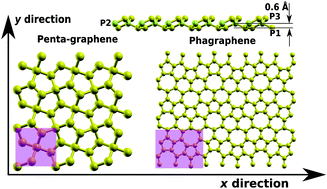Mechanical properties of monolayer penta-graphene and phagraphene: a first-principles study
Abstract
Two new graphene allotropes, penta-graphene and phagraphene, have been proposed recently with unique electronic properties, e.g. quasi-direct band gap, direction-dependent Dirac cones and tunable Fermi velocities. However, their mechanical properties have not been fully studied yet. In this work, we have performed extensive density functional theory calculations to evaluate the mechanical properties of these two materials and compared with graphene, graphane, and pentaheptite. Our simulations show that the ultimate tensile strength (UTS) and the strain corresponding to UTS in both penta-graphene and phagraphene are smaller than that of graphene. A complete set of nonlinear anisotropic elastic constants up to the fourth order have been determined for these two allotropes using the tenets of continuum mechanics by fitting the stress–strain responses under uniaxial and biaxial tension until the point of fracture. We propose a new physical explanation for penta-graphene's negative Poisson's ratio based on the atomic de-wrinkling mechanism, driven by the local Hellman–Feynman force on each atom. Additionally, we used charge density plot and virtual Scanning Tunneling Microscopy images to analyze the initiation of fracture under uniaxial and biaxial tensile loading in these two materials. The charge density plots reveal that the charge density in sp3 bonds is lower than that in the sp2 bonds. In phagraphene, all the broken bonds were found to belong to the largest carbon ring in the structure.



 Please wait while we load your content...
Please wait while we load your content...